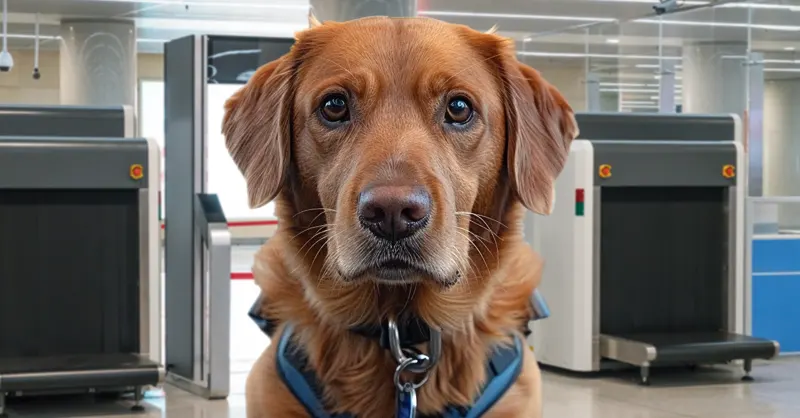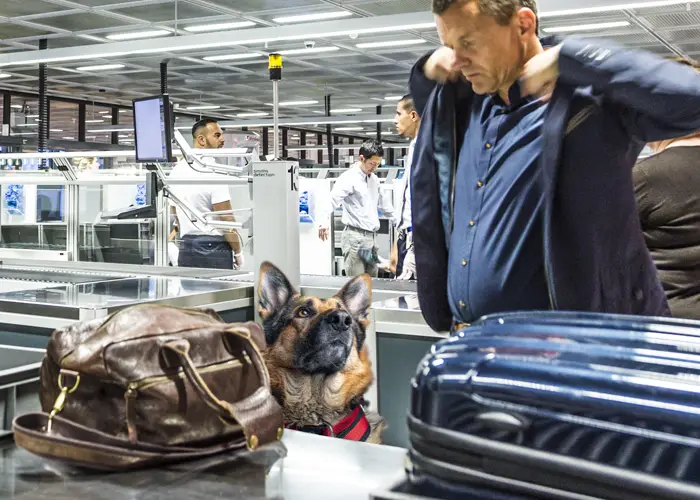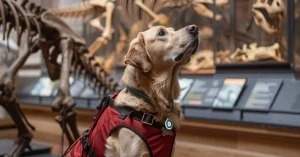How to Bring a Dog Through Airport Security

Embarking on air travel with your furry friend, whether a service dog or a beloved pet, can stir up a mix of excitement and apprehension, particularly for those navigating airport security for the first time.
Airports, with their bustling environment and strict security protocols, can indeed seem daunting. Yet, with a little preparation and insight into the process, you can ensure a smooth and stress-free experience for both you and your canine companion. This guide aims to demystify the security process, highlighting key steps and offering additional tips to enhance your travel experience.
Preparing for the Journey: Service Dogs
Service dogs and psychiatric service dogs are invaluable companions that assist individuals with disabilities, and they are granted certain privileges when it comes to air travel. Here’s how to ensure a seamless journey with your service dog:
Before Your Trip
- Documentation: The Department of Transportation (DOT) requires all service dog handlers to fill out a specific service dog form. Submitting this form to your airline in advance is crucial for a hassle-free journey.
- Identification: While not mandatory, equipping your service dog with a recognizable vest, tag, or identification card helps signal their important role to airport staff and fellow travelers.
- PSD Letters: Handlers of psychiatric service dogs might also find carrying a copy of their PSD letter reassuring.
At Security Checkpoints
- Notification: Upon reaching the security checkpoint, promptly inform the TSA agent that you are accompanied by a service dog.
- Metal Accessories: Remove any metal items from your dog, such as collars. Essential items for controlling or identifying your service dog on duty are exempt from removal.
- Metal Detector vs. AIT Body Scanner: You and your service dog will pass through a metal detector. Small service dogs can be carried. If the alarm sounds, both of you will undergo a pat-down and possibly additional screening, but rest assured, you will not be separated from your service dog. TSA may also perform an explosive residue swab on your hands post-screening.

Post-Security
Once past security, consider requesting pre-boarding from the gate agents to comfortably settle your service dog before general boarding commences.
Traveling with Non-Service Dogs
Pre-Flight Preparations
Verify your airline’s pet policy well in advance to ensure your dog meets the size requirements and is approved for travel. Be aware of any fees associated with pet travel. Most airlines will only accept smaller dogs and charge a fee for bringing one on board.
At the Security Line
Use a handheld travel carrier for your pet. You will need to remove your pet from the carrier, which should then be placed on the conveyor belt for X-ray screening.
During Security Screening
You have the option to carry your pet or lead them on a leash through the metal detector. STSA officers might swab your hands for explosive residue afterward. Following screening, proceed to a designated area to securely place your pet back into their carrier.
Additional Tips for a Smooth Experience
- Stay Informed: Familiarize yourself with TSA’s guidelines on traveling with pets and service dogs to avoid surprises.
- Early Arrival: Airports can be unpredictable, so arriving early can alleviate some of the stress by giving you ample time to navigate through the processes.
- Hydration and Comfort: Ensure your dog is well-hydrated and has had a chance to relieve themselves before entering the airport. Comfort items like a favorite toy can also help ease their stress.
- Advocate for Your Rights: Should you encounter any issues, don’t hesitate to request a supervisor or a passenger support specialist. It’s your right to ensure both you and your dog are treated with respect and care throughout the security process.
Traveling with your dog, whether a service animal or a pet, doesn’t have to be a source of stress. With the proper preparation and understanding of the process, you can ensure a smooth and enjoyable travel experience for you and your furry friend. Remember, TSA officers are there to assist you, and most are well-versed in accommodating travelers with dogs. Safe travels!
About the Author: The writing team at Service Dog Certifications is made up of folks who really know their stuff when it comes to disability laws and assistance animals. Many of our writers and editors have service dogs themselves and share insights from their own experiences. All of us have a passion for disability rights and animals.
Latest Posts

Can you bring a service dog to a museum?
Yes, you can bring your service dog to the museum! All the major U.S. museums welcome guests with service animals in accordance with the Americans with Disabilities Act (ADA). There are some areas, however, that might be off-limits. Here’s what you should know if you plan to spend a day at the museum with your […]

Read More

How to Bring a Service Dog to Six Flags Magic Mountain
Service dogs are welcome at Six Flags Magic Mountain so long as they are, according to Six Flags, “trained to do work or perform tasks for people with disabilities.” Of course, your dog must be housebroken and remain on a leash or harness and under your control while at the park — and the park […]

Read More

When Stores Can Refuse Your Service Dog
According to the Americans with Disabilities Act (ADA), service dogs should be allowed into any store most of the time. A store owner can legally exclude a service dog if they are actively growling, snapping at, or frightening customers, or if the dog is obviously out of the control of its owner. Ordinary behaviors — […]

Read More